#Jacquetta Woodville
Text

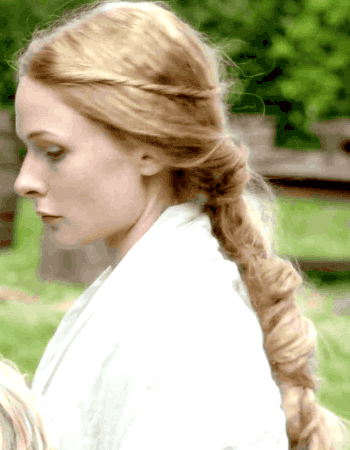
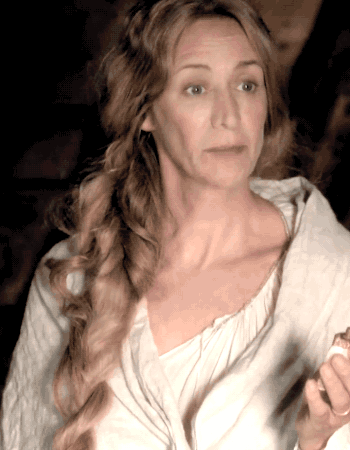






The White Queen 1.01: In Love with the King + Hair Moments
#The White Queen#TheWhiteQueenEdit#Elizabeth Woodville#Jacquetta of Luxembourg#Jacquetta Woodville#weloveperioddrama#perioddramaedit#period drama#historical drama#In Love with the King#costumeedit#costumes#costume drama#Awkward-Sultana
203 notes
·
View notes
Text


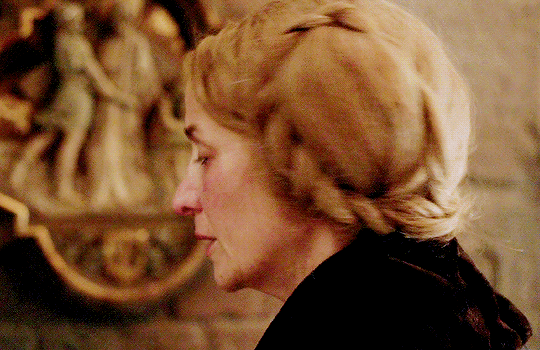
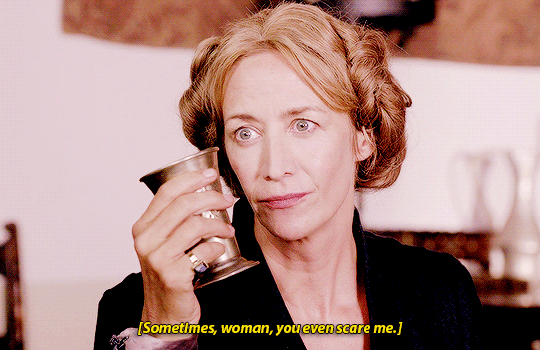
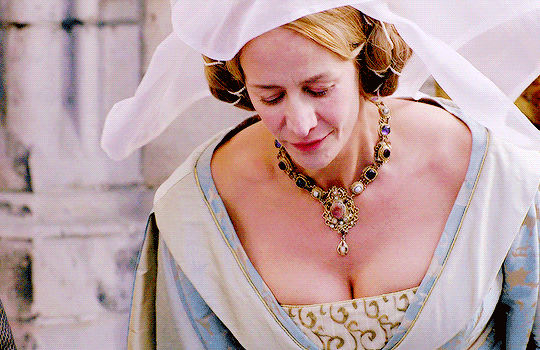

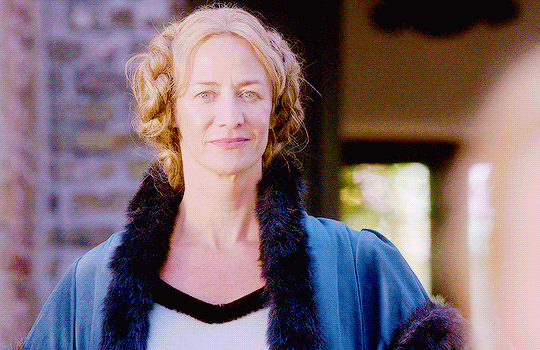
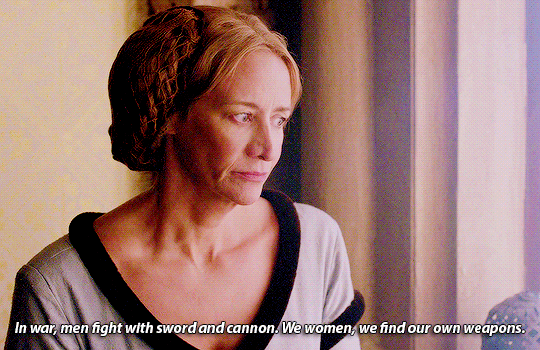



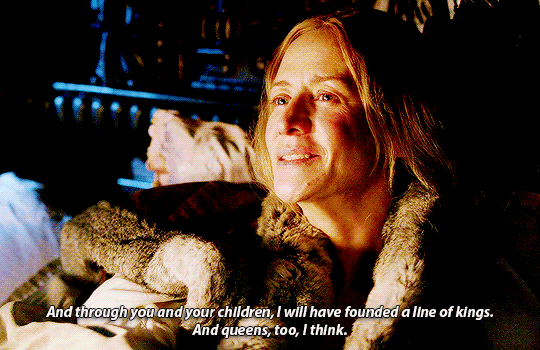

THE WHITE QUEEN 10 YEAR ANNIVERSARY WEEK | Day 3 (August 16): Most Underrated Character → Jacquetta of Luxembourg
If a witch is capable of the darkest and most evil deeds. If a witch will do anything to see their own needs met, regardless of the pain and suffering that they cause others. Then, indeed, there is a witch in this room, Lord Warwick. But it is not me.
#the white queen#twqedit#perioddramaedit#twq10#Jacquetta of Luxembourg#jacquetta woodville#Janet McTeer#S1E03 The Storm#S`1E01 In Love With The King#S1E02 The Price of Power#S1E04 The Bad Queen#S1E06 Love and Marriage#my edits
265 notes
·
View notes
Text

#the white queen#twqedit#perioddramaedit#david oakes#max irons#aneurin barnard#janet mcteer#amanda hale#rebecca ferguson#faye marsay#james frain#my edits#george plantagenet#edward iv#richard iii#jacquetta woodville#margaret beaufort#elizabeth woodville#anne neville#richard neville#another rare promo I have found
59 notes
·
View notes
Text
Clothing colour symbolism in The White Queen
So. I was looking at this image and wondering why Richard stands out so much in terms of colour and what it might mean, which led me down a rabbit hole. I discovered that there's one too many coincidences to be casual.
So, here's my theory about each character and what their clothing says about them and their motives.
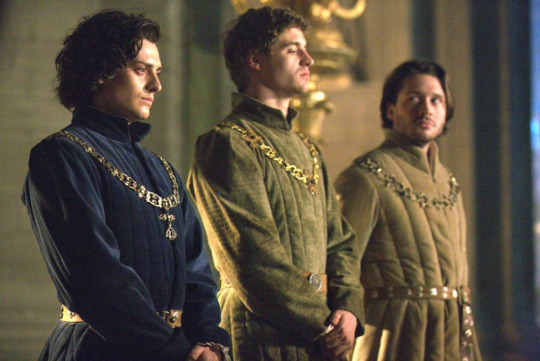
Richard Duke of Gloucester

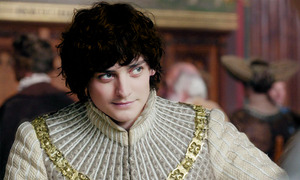
Richard, throughout the first episodes of the show, is mostly seen wearing either blue or Edward's trademark colours (cream, white). Blue signifies loyalty, a trademark of Richard ("Loyaulté me lie") and that loyalty is to Edward.


After Edward's death, he is seen wearing a darker shade of blue (blue + black = loyalty and grief). He is wearing full black after the deaths of Edward his son and of Anne.
Edward IV
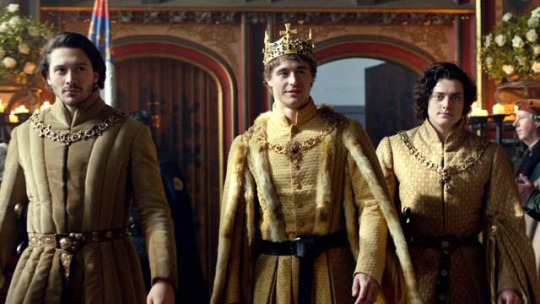
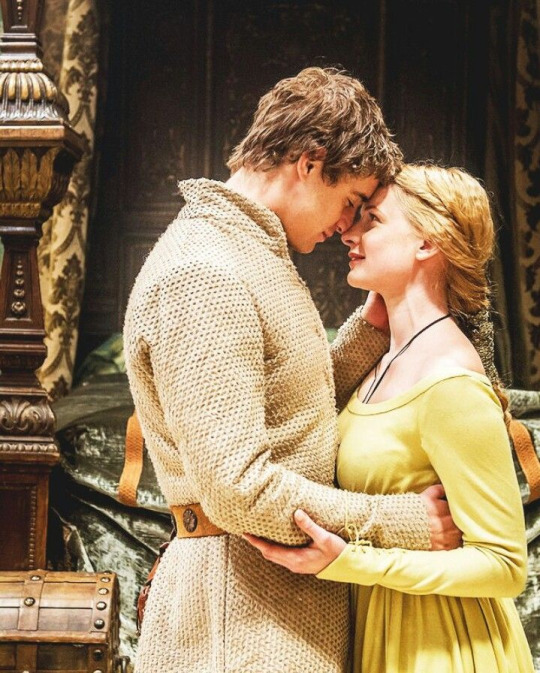
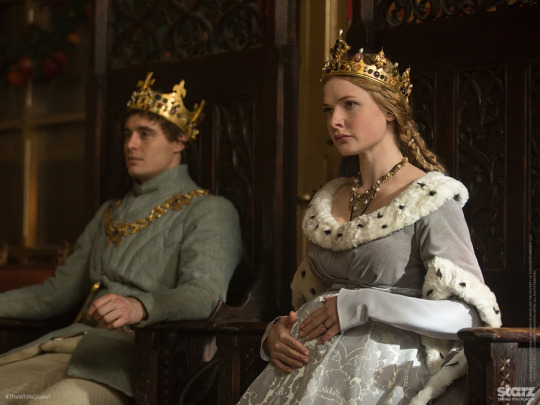
Edward wears mostly cream or beige. It could be interpreted as white (purity), in some cases even as yellow (generosity). I haven't found much about cream: maybe it was normal nobility clothing, even though the most common association with nobility is royal purple.
The most interesting thing about his outfits is when other characters match him to show their loyalty to him, most notably Elizabeth and Richard, but also George after his betrayal of Warwick.
Sometimes, him and Elizabeth alternate, with one scene where one is wearing cream and the other light blue and viceversa, which may represent their loyalty to each other. I think, but I am not sure, that the one who is wearing cream is the main focus of the scene, whereas the blue-wearer is showing their support. But I don't remember the context of the scenes, so this is just conjecture.
His colours are always light though, be it yellow or blue.
George Duke of Clarence
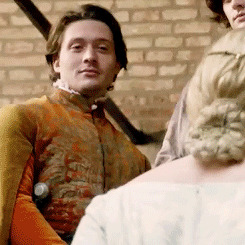
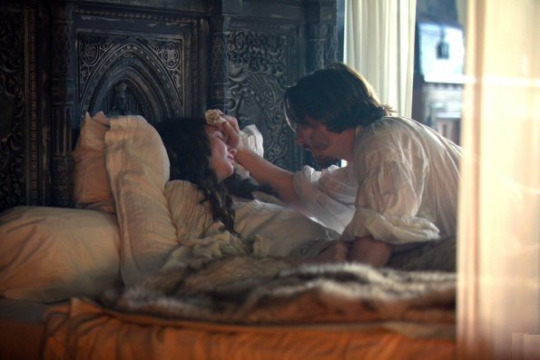
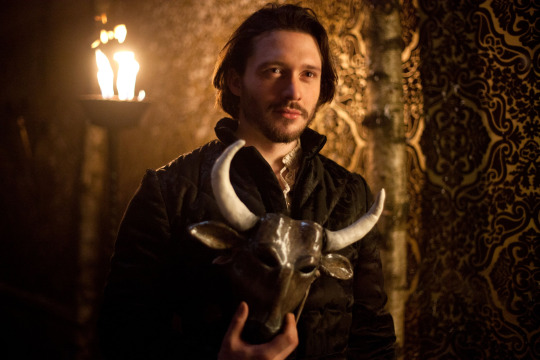
I would have expected George to wear a lot of green, considering it is the colour of envy, so I was quite surprised when I realised he didn't so much (he still does sometimes, though). I had noticed, however, that in his introduction scene, while both his brothers are wearing cream/beige (matching), he stands out with orange clothes.
What does orange represent? "Worthwhile ambition". Checks out.
He sheds the orange definitively by the time he joins Edward's side again (as shown in the top picture) and he wears progressively lighter clothing, possibly showing his redemption? By the time of Isabelle's death and his own, he is only wearing a white chemise. He is visibly wearing the chemise under black clothes (grief) at the masked party.
But, do you know who wears a lot of green?
Richard Earl of Warwick
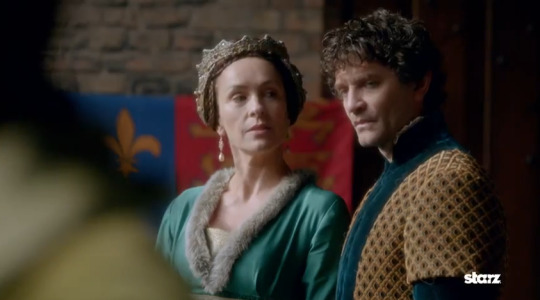
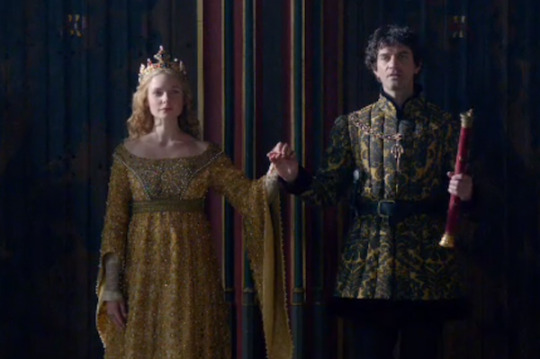
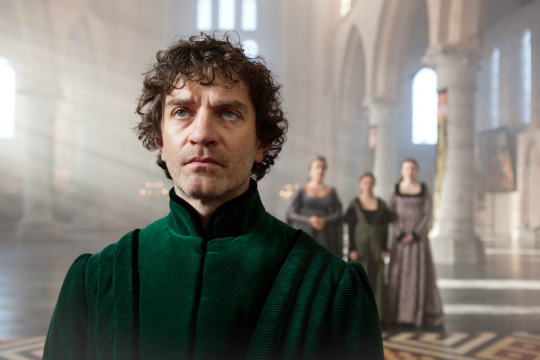
Do I need to explain this one? He envies both Edward and the Woodvilles for the power they hold.
He wears some yellow, which represents generosity, so long as he is keeping up friendly appearances and up until his betrayal of Edward. He does not, however, wear white, because the last thing he wants is peace. He is just acting like it for what he thinks is Edward's sake.
Queen Elizabeth
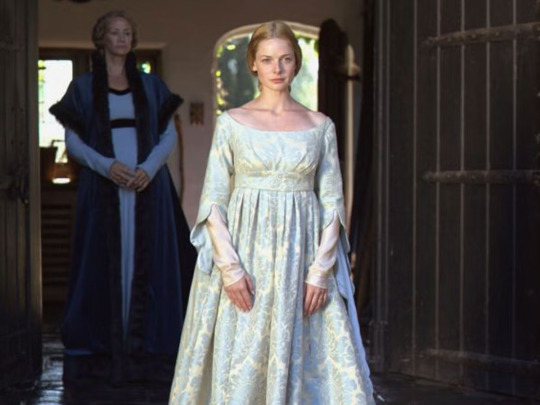

White is the colour of peace (in the first scene she is trying to make peace with Edward). We also see specks of blue (loyalty), probably to her dead husband.
However, she is most often seen wearing yellow (generosity), most notably at her coronation, white (purity) and light blue (loyalty). Much like Richard, she often matches with Edward.
Queen Anne
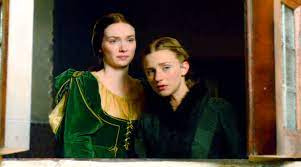

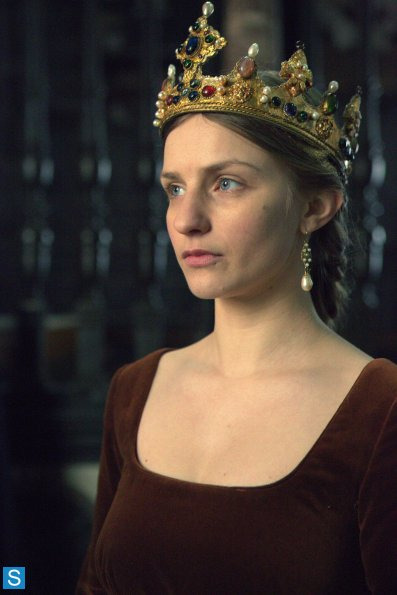
Anne is quite funny. She changes colours quite a lot, sometimes matching Richard, her sister or her father, other times not matching anyone else.
I think it shows her loyalty is to the people she loves and not to loyalty itself, unlike her husband. However, she is also ambitious and follows her own agenda, but she's always careful not to step on any toes.
She is loyal, generous, reliable and sometimes envious, which all shows in her clothing throughout the show.
Literal Queen.
Margaret Beaufort
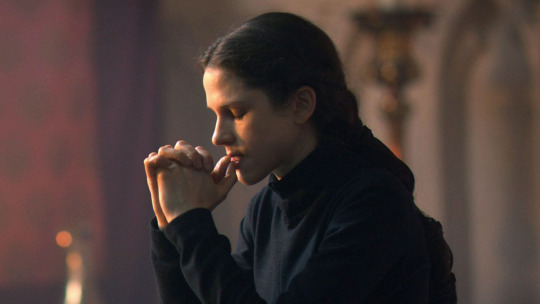

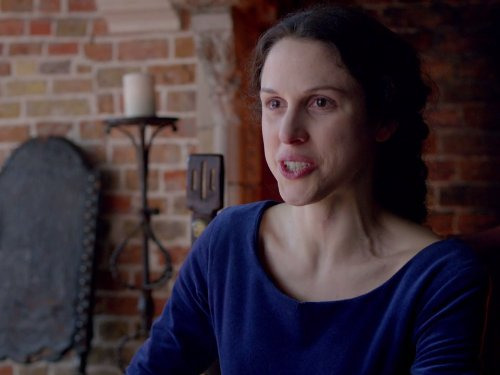
Say what you want about her, but I am in love. Her strength of character is incredible and she is so funny, but this is unrelated to the post.
Black = the colour of grief. Her character arc is loss and gain, but the latter only comes into play in the literal last minute of the show. So loss of everything and subsequent grief.
Red = the colour of martyrdom. She is the most pious and self-sacrificial character in the whole show.
Blue = undying loyalty to the House of Lancaster, despite the risk it poses to her life and that of the people around her.
Jacquetta Woodville


Blue all the way down. Her loyalty is not to a house, or to a King, but to her daughter.
Isabelle Neville, Duchess of Clarence
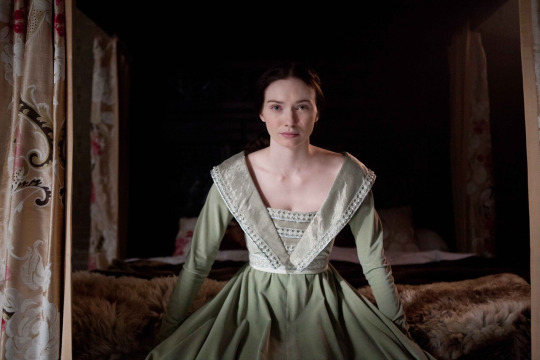
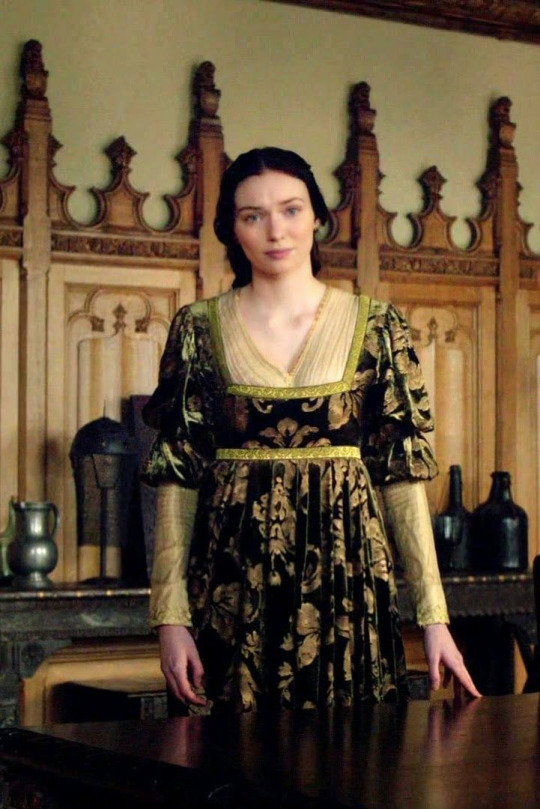
Lots of green, like her dad, but mostly in a lighter shade, showcasing innocence.
She is also quite envious of Elizabeth, but not to the point of starting a war about it, so less envious (therefore, less green) than her father.
In her case, green might even represent youth.
Anthony Woodville


Brown, the colour of honesty, stability and reliability.
He is not afraid to speak his mind to Elizabeth ("your marriage was fake"), but he is also her rock throughout the show.
#let me know your thoughts I had a lot of fun making this!!!#the white queen spoilers#the white queen#richard iii#edward iv#george plantagenet#elizabeth woodville#anne neville#warwick#margaret beaufort#isabelle neville#jacquetta woodville#anthony woodville
36 notes
·
View notes
Note
thinking about the war of the roses and how all the women involved would have probably gotten along really well in another time :(
Doubly sad because Cecily Neville and Margaret of Anjou were very courteous and considerate of each other before the conflict began, and Margaret and Jacquetta of Luxemburg really were very good friends. Elizabeth Woodville's of a different generation, but she did seem to be sympathetic to Margaret after her defeat considering she joined a fraternity that Elizabeth was part of and was allowed to be depicted as a former queen. I think, in a different time, they would have gotten along very well.
I think the only two women who were on "differing" sides but were enabled due to circumstances to get along and ultimately ended up in a mutually beneficial position due to a common goal were Elizabeth Woodville and Margaret Beaufort. We don't know how personally close they were, well-intention seems likely, considering the role Margaret played in the birth of Elizabeth's last child, how they worked together very well for the marriage alliance between their kids, and how there was no recorded conflict between them after Henry VII ascended the throne. I believe they also went to mass together with their children once?
just thinking random thoughts lol
Hi! Yes, practically all the important women involved in the wars of the roses had a good or at least cordial relationship with each other, which is why it's always so baffling to see histfic authors write them hating each other with such fervour just because they ended up on opposite sides of the war. Most of them were on the same side at some point: @heartofstanding can talk more about Cecily and Margaret of Anjou's relationship, but Margaret and Jacquetta were definitely good friends for a long time. Jacquetta was among the three or four most important women held in high regard by Margaret going by the gift records of this queen, to say nothing about the fact that Jacquetta's husband was created a baron and a knight of the Garter(!!) during Margaret's time, and only after her arrival in England.
Elizabeth Woodville would have probably appreciated Margaret's regard for her family too, which is why Weir writing Elizabeth & Jacquetta calling Margaret of Anjou 'the pretended Queen Margaret, our great enemy' doesn't make any sense! Even later when they were on opposite sides, I don't think the level of animosity would have risen that high, and you can see a mark of friendliness also in the fact that Elizabeth Woodville allowed Margaret to join the same fraternity of which she was a patron. Perhaps it was her regard for Margaret that made Elizabeth take up the patronage of Queen's College (founded by Margaret) too—a respect for her predecessor's vision.
I'm still of the opinion that Elizabeth Woodville, her daughter and Margaret Beaufort were probably good friends (as I explained here and here). Besides, Margaret Beaufort seems to have held great admiration for Cecily Neville (considering she based her household and routine on Cecily's) and even Cecily may have come to like Margaret Beaufort, going by the way she left Margaret some religious books in her last will when not even all her surviving relatives were contemplated. Probably the only women that were on opposite sides that didn't get along well were Margaret Beaufort and Margaret of York. In a letter thanking the earl of Ormond for a pair of gloves he sent her from Flanders, Margaret wrote:
‘I thank you heartily that ye list so soon remember me with my gloves, the which were right good, save they were too much for my hand. I think the ladies in that parts be great ladies all, and according to their great estate they have great personages’.
She was, of course, taking a dig at Margaret of York, who was dowager duchess of Burgundy ('great lady') and famously tall ('great personage'). Considering Margaret of York was at that time creating great problems for Margaret Beaufort's son by lying about Perkin Warbeck and funding an army against him—probably in Margaret Beaufort's opinion, for no reason—it's understandable that she would not have had the greatest sympathy for the dowager duchess. They had no previous history of friendship.
#ask#margaret beaufort#elizabeth woodville#margaret of anjou#jacquetta woodville#margaret of york duchess of burgundy#cecily neville duchess of york#elizabeth of york#anon
36 notes
·
View notes
Text
On 12 July 1467, before the battle of Edgecote, Warwick and the duke of Clarence released a manifesto attached to a petition by Kent rebels. In it, they spoke against the:
disceyvabille covetous rule and gydynge of certeyne ceducious persones; that is to say, the Lord Ryvers, the Duchess of Bedford his wyf, ... Ser John Wydevile and his brethren, Ser John Fogge, and other of theyre myschievous rule opinion and assent, wheche have cause oure seid sovereyn Lord and his seid realme to falle in grete poverte of myserie, disturbynge the mynystracion of the lawes, only entendyng to thaire owen promocion and enriching.
Jacquetta was the only woman named in the manifesto, among important knights and influential men at court, all men of war, and the fact that she was mentioned shows that she was regarded as politically important in her own right, and not merely as Rivers' wife. The manifesto was meant as propaganda for the general public and written to appeal to the masses. Perhaps this is why Warwick and Clarence felt the need to clarify that the duchess of Bedford was Rivers' wife. There do not seem to be many other occasions during this period in which a woman was particularly singled out in this way. The duchess of York, for example, was not implicated in her husband's many quarrels with Henry VI and his councillors. Jacquetta's inclusion shows, at the very least, that Warwick and Clarence considered her powerful and influential in court and had a very personal hatred against her.
Jacquetta of Luxembourg, Duchess of Bedford and Lady Rivers (c. 1416 - 1472), Lucia Diaz Pascual
#she 😌#jacquetta of luxembourg#jacquetta woodville#the wars of the roses#history#english history#mine*#quotes
5 notes
·
View notes
Text



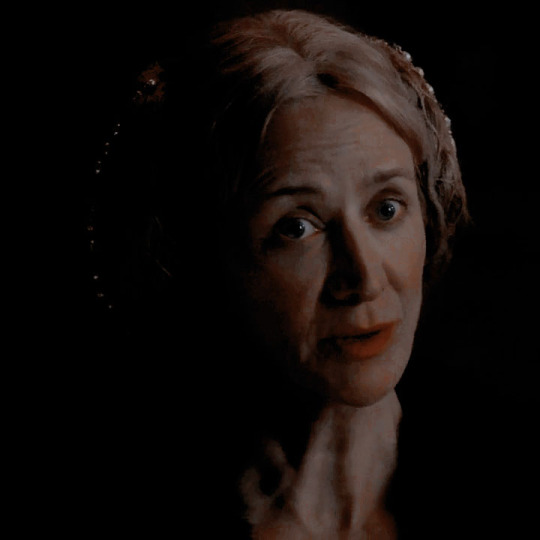

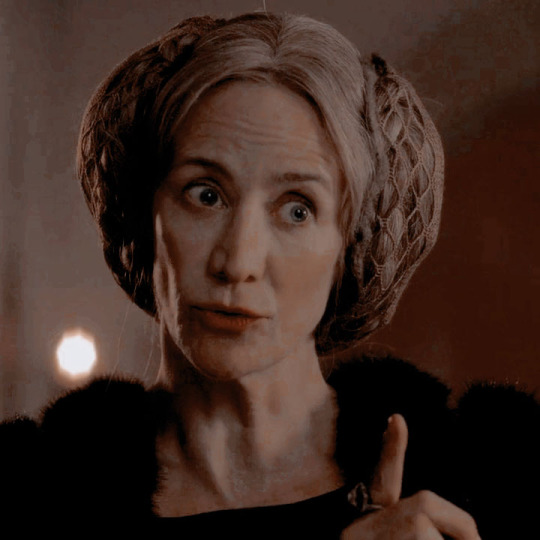



#jacquetta of luxembourg icons#jacquetta woodville icons#jacquetta of luxembourg#janet mcteer icons#janet mcteer#jacquetta woodville#psd icons#icons with psd#actress#actress icons#tv series#tv series icons#the white queen#the white queen icons
4 notes
·
View notes
Text



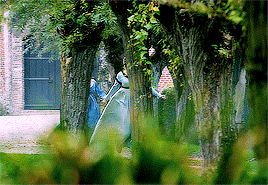



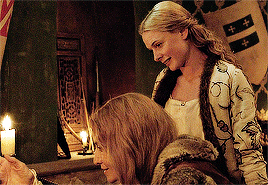
JACQUETTA and ELIZABETH moments
requested by @heather123fan-blog ♡
#the white queen#twqedit#elizabeth woodville#jacquetta of luxembourg#rebecca ferguson#janet mcteer#period drama#periodramaedit#weloveperioddrama#onlyperioddramas#mine#byfefa#sorry this is lazy work but i'm not well#i'll try to make another set later
140 notes
·
View notes
Text

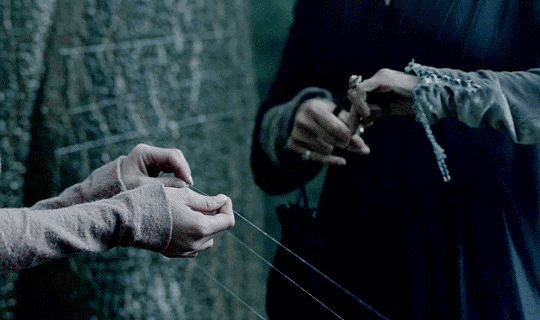

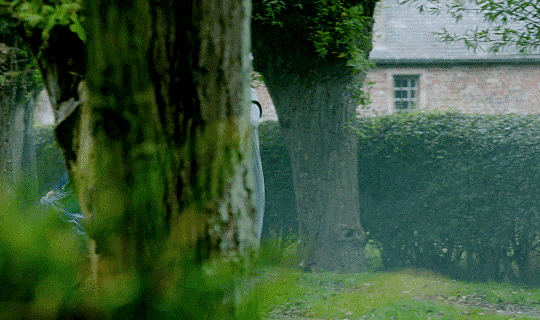

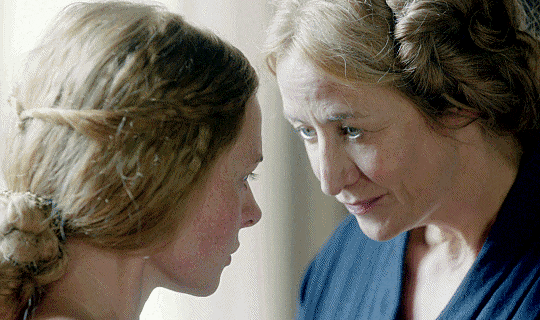
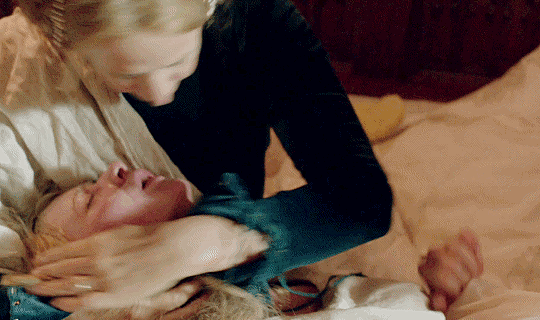


THE WHITE QUEEN 10-YEAR ANNIVERSARY WEEK
Day Six - Favourite Family Dynamic: Elizabeth Woodville and Jacquetta of Luxembourg
#the white queen#twq10#twqedit#elizabeth woodville#jacquetta of luxembourg#perioddramaedit#perioddramasource#weloveperioddrama#perioddramagif#femalegifsource#adaptationsdaily#cinematv#filmtvcentral#smallscreensource#femalecharacters#rebecca ferguson#janet mcteer#my edit
188 notes
·
View notes
Photo
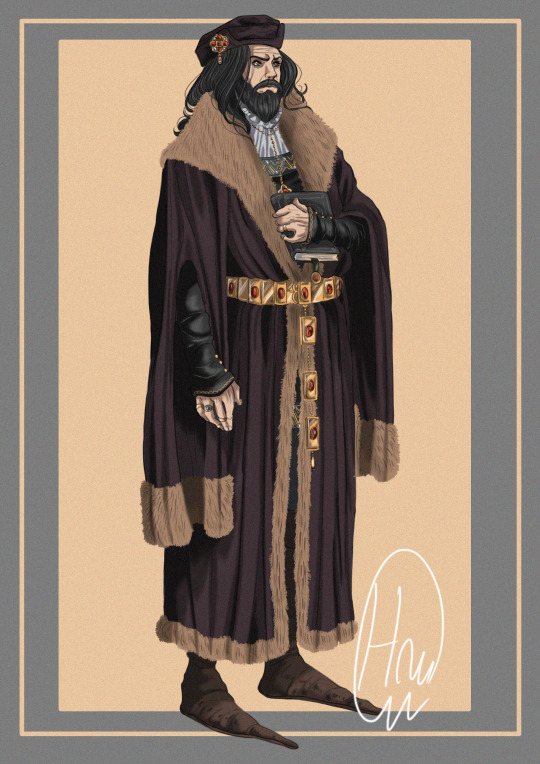

Richard Neville, 16th Earl of Warwick
&
Jacquetta of Luxembourg
#the wars of the roses#15th century#medieval#middle ages#british history#medieval fashion#historical#character design#digital art#artists on tumblr#my art#edward iv#elizabeth woodville#elizabeth of york#jacquetta of luxembourg#richard neville#isabel neville#henry vi#richard iii#the white queen#the white princess#plantagenets#royals
165 notes
·
View notes
Note
The Tudor chest- who has a podcast with some historians that come on, on Instagram said Elizabeth woodville was a commoner who captured the kings heart. Is this true?
The whole 'commoner' thing bugs me because, in absolutely every sense of the word, Elizabeth Woodville was not a commoner. She was, on her father's side, the daughter of a well-known and quite celebrated knight who fought alongside some of the top brass during the early part of Henry VI's reign. Her father also held a high position in the household of John duke of Bedford, uncle to Henry VI and the English regent in France. His family had held lands in Northamptonshire for more than a century and several of his ancestors had served as sheriff. Which is all to say that the Woodville family, while not amongst the highest echelons of nobility, were firmly part of the landed gentry.
And that doesn't even take into account Elizabeth's mother, Jacquetta de St. Pol, whose father was a liegeman of the dukes of Burgundy, and whose extended family had married into both the French and the Burgundian royal families. She was also married, for several years, to the aforementioned John duke of Bedford, which made her the literal second lady in England after the dowager queen Catherine of Valois. After Bedford's death, she scandalously married Richard Woodville, but it is worth keeping in mind that she continued to style herself Duchess of Bedford until her death.
So, no, Elizabeth Woodville was not in any sense a commoner. A lot of that rhetoric comes from anti-Woodville propaganda spread first by Richard earl of Warwick, and eventually picked up by George of Clarence and Richard of Gloucester (later Richard III), from whence it made its way into the official Tudor historiography of the civil wars.
#england#wars of the roses#elizabeth woodville#jacquetta de st pol#richard woodville#john duke of bedford
17 notes
·
View notes
Text
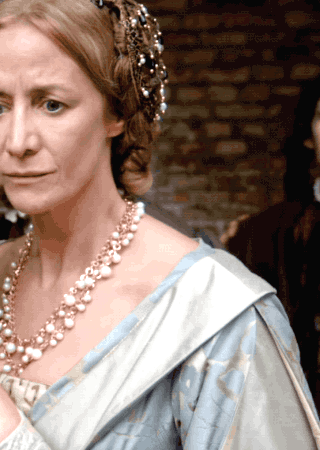



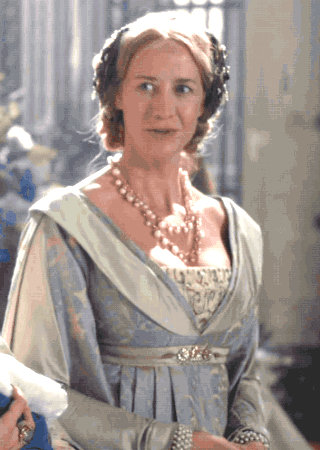
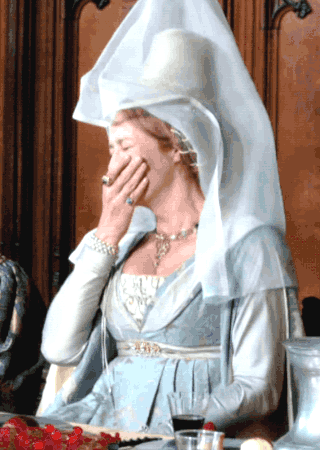



(Almost) Every Costume Per Episode + Jacquetta Woodville's light blue gown in 1x02
#The White Queen#TheWhiteQueenEdit#weloveperioddrama#perioddramaedit#period drama#historical drama#Jacquetta Woodville#Jacquetta of Luxembourg#TWP 1x02#The Price of Power#costumeedit#costumes#costume drama#Almost Every Costume Per Episode#Awkward-Sultana
89 notes
·
View notes
Text









THE WHITE QUEEN 10 YEAR ANNIVERSARY WEEK | Day 1 (August 14): Favorite Episode → 1.01 In Love With the King
You are a girl from the house of Lancaster, and you live in a country that is divided. You may not fall in love with a York king, unless there is some profit in it for you. Your life will not be easy because you wish it to be so. You will have to wade through blood and you will know loss, you must be stronger.
#the white queen#twqedit#perioddramaedit#twq10#elizabeth woodville#edward iv of england#jacquetta of luxembourg#S1E01 In Love With the King#my edits
315 notes
·
View notes
Photo

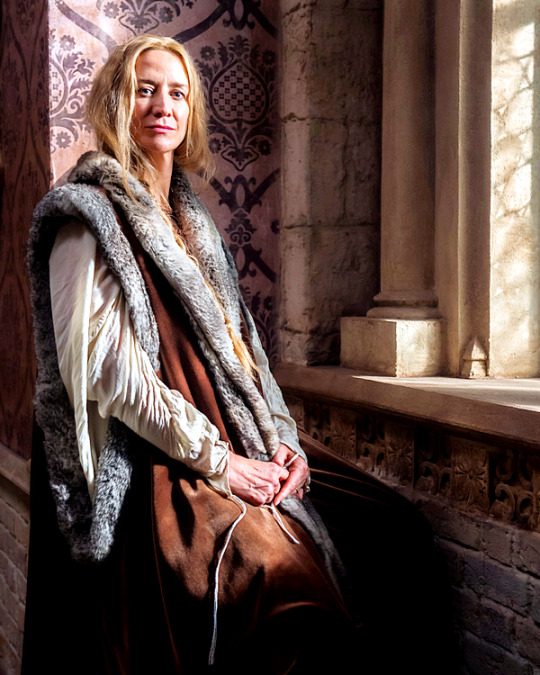
61 notes
·
View notes
Note
After reading your article, marriages like Eleanor and Humphrey, Katherine and John, Henry VIII and Ambeline are described as women seducing men, and men being victims... But marriages like Owen Tudor and Catherine, Richard Woodville and Jacqueta in Luxembourg, will have completely ignored the subjective initiative of women, and the description of men seducing women should be class/gender discrimination?
Hi anon, I think you're asking about what kind of narratives there were around the marriages between men and women of significantly higher status, the inverse of the type of relationships I was talking about in this blogpost I made on my sideblog that focused on Eleanor Cobham, where women married men of much higher status than themselves.
There seems to be comparatively little scholarship in this area and it would be fascinating to see what commonalities and links a study would produce. The marriage of men to women of significantly higher status than themselves does appear to have been fairly common but does not seem to have generated the same amount of commentary and infamy as the relationships between women who married men of significantly higher status. I don't mean that they didn't contract comment but that there was little sustained comment - who remembers Alice de Lacey and Eubulus le Strange? Katherine Woodville and Sir Richard Wingfield? The only high profile case I can think of is Joan of Kent and Thomas Holland.
From what I could find, there does not seem to be the equivalent narrative of the man of lesser status seducing or bewitching the high-status woman into marriage. Instead, what seems to be the common theme is, as Katherine J. Lewis says, "a standard medieval antifeminist notion: that women were naturally inclined to lust and rendered irrational to it."
Lewis was talking specifically about the case of Catherine de Valois. One contemporary chronicler remarked that she was "unable to fully control her fleshly passions" when she married Owen Tudor and even chastises her for keeping the marriage secret "so she did not claim honourable title [of marriage] during her lifetime". Tudor was described by another chronicle as "no man of birthe nother of lyflode", implying his unworthiness. But there seems to have been little rancour or blame directed at Tudor.
It's not until the 16th century where the image of Catherine as governed by her lust became the dominant narrative around her remarriage, perhaps because the rise of the Tudor dynasty and Henry VIII's marital life lent itself to it. One notable example is Edward Hall, who in 1548 described Catherine as:
beyng young and lust, folowyng more awne appetite, then frendely counsaill and regardyng more her priuate affecion then her open honour
He describes Tudor, on the other hand, as a "goodly gentilman & a beautyful person, garnished with many Godly gyftes, both of nature & of grace" - so the issue here is not that Tudor is a social-climber but that Catherine is at the mercy of her sexual desires. Probably the most extreme example of this is Nicholas Fox's claim that Catherine "bey[ed] like a very dronkyn whore" in bed with Tudor - a factoid often gleefully repeated by historians and commentators to proclaim Tudor's sexual prowess despite the fact that Fox made the claim in 1541 and is far from a reliable source. The fact that it has been almost universally used to celebrate Tudor by demeaning Catherine shows how long-lasting this type of narrative is. Polydore Vergil similarly describes Catherine dismissively as "yonge in yeres, and thereby of lesse discretion to judge what was decent for estates" and then focuses on Tudor's lineage and good qualities. Kavita Mudan Finn notes that he "succeeds in suppressing what on the surface to appears to be her agency - a second marriage of her own free will - by literally changing the subject to Owen, and by extension, Henry, Tudor". This same suppression of Catherine's agency appears again in Michael Drayton's Englands Heroicall Epistles where Catherine appears to be acting on her own initiative, wanting Tudor for herself, but Drayton has Tudor displace Catherine's agency by citing destiny as the impulse behind their union. Catherine "is reimagined as a 'a Royall Prize' for Tudor to claim", per Finn. In short, Catherine appears to be cast as oversexed and/or uncontrollable while Tudor's individual qualities and descent are celebrated and their union is seen as governed by destiny and fate.
Joan of Kent has fared similarly to Catherine in that she is primarily remembered as governed by her lust. Famously described as Froissart as "a woman more beautiful and amorous than any in the realm" and by Adam of Usk as a "woman given to slippery ways", Joan had married Thomas Holland clandestinely, then been convinced by her family to marry William Montagu (the son of the Earl of Salisbury). Around eight years later, Holland then petitioned the papacy to return Joan to him, resulting in a public scandal. When Holland died in 1360, Joan made another shocking match, this time marrying Edward of Woodstock, Edward III's eldest son and heir known to history as "the Black Prince". Joan was sometimes referred to the "Fair Maid of Kent" or "the Virgin of Kent", probably sarcastically. Thomas Austin's wife was alleged to claim that Joan's son with the Prince, Richard II, was "nevere the prynses son and ... his moder [i.e. Joan] was nevere but a strong hore". Froissart recorded a conversation between Richard and his usurper, Henry IV, where Henry alleged that a bastard gotten in adultery. W. Mark Ormrod also suggested that various narratives about Joan in the Peasants Revolt built on her carnal reputation and may have reflected even more salacious tales floating around. Thomas Walsingham emphasises Joan's other alleged, inordinate appetites around the time of her death - gluttony ("hardly able to move about because she was so fat") and a love of luxury.
It is, however, very difficult to determine how much of Joan's reputation was shaped to her marriage to a man of significantly lower status or how much it was shaped by her marriage to the man, at the time, was to be the next king of England and to whom her marriage was both scandalous and unconventional. Likely, her reputation was formed by both marriages, both feeding the other. The deposition of her son also meant that her reputation was used as a way of slandering him. Thomas Holland, on the other hand, barely seems to be mentioned, let alone criticised - even if he was in his mid-20s when he married the 12 year old Joan. In fact, Henry Knighton's chronicle positions Holland as seduced by her, crediting Holland's "desire for her" as the cause that she had been divorced from her second husband, Montagu.
Jacquetta and Richard Woodville do not seem to have drawn the same level of commentary. Lynda J. Pidgeon notes that "the marriage ... aroused no comment from English chroniclers until after the couple’s daughter, Elizabeth, married King Edward IV in 1464". though it was recorded in by continental chronicles, such as Enguerrand de Monstrelet, who recorded recorded:
In this year [1436], the duchess of Bedford, sister to the count de St. Pol, married, from inclination, an English knight called sir Richard Woodville, a young man, very handsome and well made, but, in regard to birth, inferior to her first husband, the regent, and to herself…
This has similar echoes to Hall's and Vergil's comments about the marriage of Catherine and Owen Tudor - Jacquetta marries from "inclination" a man inferior to herself but who is otherwise "very handsome and well-made". Hall includes the story of their marriage immediately after his account of Catherine and Tudor, which, as Finn says, "hints at a growing interest - and indeed, anxiety - about women's desires". Like Catherine, Jacquetta is described as marrying Woodville "rather for pleasure then for honour" and "without coū∣sayl of her frendes". Her family is said to disapprove but can do nothing - sentiments also found in Monstrelat and Jean de Wavrin. Rather than dwelling on Woodville's qualities as he does with Tudor's, Hall describes Woodville "lusty" and notes that he was made Baron Rivers, which may indicate . He does, however, mention the marriage of their daughter, Elizabeth, to the future Edward IV, a subject which he promises to return to.
The continuation of Monstrelet's chronicle links Jacquetta and Woodville's marriage to that of their daughter, Elizabeth Woodville's marriage to Edward IV, "thus linking these two unorthodox women together", per Finn. Here's what this continuation says:
After the death of the duke, his widow following her own inclinations, which were contrary to the wishes of her family, particularly to those of her uncle, the cardinal of Rouen, married the said lord Rivers, reputed the handsomest man that could be seen, who shortly after carried her to England, and never after could return to France for fear of the relatives of this lady.
It is likely that Jacquetta's unconventional second marriage helped render Jacquetta's reputation suspect and tempting to speculate that that it rendered her vulnerable to the accusations that she had used witchcraft to make Edward IV marry her daughter, Elizabeth Woodville. The unpopularity in France and Burgundy of her first marriage to John of Lancaster, Duke of Bedford and Regent of France may have also played into this view. Ricardians have certainly framed her as her as a seductress and her family as scheming, power-hungry social climbers in that regard - while also treating her as driven by her lust for Woodville. However, there is no evidence that this was the view of Jacquetta at the time, either in England or in France.
Richard Woodville is unique amongst the three men I've mentioned in that he seems to have been reviled as a man "brought up from nought", along with the rest of his and Jacquetta's prodigious offspring. This view has been spurred on by Ricardian historians that have reviled Elizabeth Woodville, where the entire family is depicted as a brood of grasping social climbers. An invasive species, if you will. I think it is likely that Jacquetta and Richard Woodville's marriage has helped furnish this view, particularly for Woodville himself. However, this particular image of Woodville and his children only seems to emerge with Elizabeth's marriage to Edward IV and the tensions between Edward, Woodville, George, Duke of Clarence and Richard Neville, Earl of Warwick ('the Kingmaker'), rather than Woodville's marriage to Jacquetta.
In short: the tendency seems to be depict the high-status woman as indulging in her own sexual desires and acting on her own will, disregarding reason, counsel and sense, while the man of lesser-status is considered handsome but bears little or no responsibility for seducing the woman. He is of less interest to contemporary chroniclers. Woodville seems to be an exception, rather than the norm, in being seen as guilty of social climbing and there it is the marriage of his daughter, not his own marriage, that gave that reputation. Owen Tudor, as the patriarchal originator of the Tudor dynasty, was celebrated by Tudor-era writers for his qualities and Welsh lineage - it would be easy to conclude that had he not been the grandfather of Henry VII, he would be entirely forgotten.
There do not seem to be any contemporary claims than Tudor, Holland or Woodville seduced, bewitched or raped their wives, whatever historical fiction novelists or pop historians claim. However, it should be noted that there are many cases where other high-status women could be abducted and forced into marriage. One example is Alice de Lacey, Countess of Lancaster. For those cases, I suggest reading Caroline Dunn's Stolen Women. It is far too long and complicated subject to summarise in a tumblr post.
Sources:
Caroline Dunn, Stolen Women in Medieval England: Rape, Abduction, and Adultery, 1100–1500 (Cambridge University Press, 2017)
David Green “‘A woman given to slippery ways��? The reputation of Joan, the Fair Maid of Kent”, People, Power and Identity in the Late Middle Ages: Essays in Memory of W. Mark Ormrod (Routledge, 2021, eds. Gwilym Dodd, Helen Lacey, Anthony Musson)
Katherine J. Lewis, “Katherine of Valois: The Vicissitudes of Reputation”, Later Plantagenet and the Wars of the Roses Consorts: Power, Influence, and Dynasty (eds. J. L. Laynesmith and Elena Woodacre, Palgrave 2023)
Kavita Mudan Finn, The Last Plantagenet Consorts: Gender, Genre, and Historiography, 1440-1627 (Palgrave Macmillan, 2012)
W. Mark Ormrod, "In Bed With Joan of Kent: The King's Mother and the Peasants Revolt", Medieval Women: Texts and Contexts in Late Medieval Britain (ed. Jocelyn Wogan-Browne, Rosalynn Voaden, Arlyn Diamond, Ann Hutchison, Carol Meale, and Lesley Johnson, Brepols 2000)
Lynda J. Pigdeon, Brought Up Of Nought: A History of the Woodville Family (Fonthill 2019)
#god i hope this makes sense as i'm tired and i've been working on this for too long#also i don't know a lot about the woodvilles so most of my discussion of them is drawn from a quick research session so#jacquetta of luxembourg#richard woodville#joan of kent#thomas holland#catherine de valois#owen tudor#asks#anonymous#text posts
9 notes
·
View notes
Note
Hi! I’m reading “Later Plantagenet and Wars of the Roses Consorts” after seeing several interesting posts on it, and I’m a little confused because in Joan of Navarre’s section, Elena Woodacre said that Joan “was certainly the only English queen to have been supposedly accused of witchcraft, even if other royal women were rumored to have dabbled in dark arts”. I may have misunderstood, but didn’t Richard III accuse Elizabeth Woodville of the same in formal Parliament? I think his (Richard’s) accusation was far more explicit, actually: Henry V’s Parliament Rolls say “Joan, queen of England, had plotted and schemed for the death and destruction of our said lord the king in the most evil and terrible manner imaginable”. It’s evident that they probably mean witchcraft, but it’s the Chronicles of London that specify what she was accused of; Henry’s Parliament does not. In Richard’s “Titulus Regius”, however, it’s explicitly stated that “by Sorcery and Witchcraft, committed by the said Elizabeth, and her Mother, Jacquetta" (doubly striking because Jacquetta had already stood trial and been cleared of those charges, with her innocence recorded in Parliament). I think it was probably just a confusing wording choice; I think Woodacre probably meant that Joan was the only queen to be *detained* on the basis of witchcraft (which she mentions in another chapter), although the book also mentions that Joan was never actually formally tried or charged for witchcraft or any other crime (the way Eleanor Cobham and Jacquetta were) so I'm a little confused whether the causes for her detainment were formal or informal or even specified. I don't know much about Joan, though, so maybe I've gotten a few things mixed up.
Hello! Yeah, honestly I don't see how you can say Elizabeth Woodville wasn't actually accused of witchcraft. The allegation against her in parliament doesn't go in full detail but none of the allegations in Titulus Regius do, including the allegation of bigamy, which according to all logic should be really detailed and discussed at length yet it's not. There's also a letter by Richard to his adherents in the North dated 10 June 1483 accusing Elizabeth and her kin to plan his and Buckingham's murder by casting their horoscope, which was something that Eleanor Cobham was also accused of, if I'm not mistaken. I'm calling my friend @une-sanz-pluis here to see if she has any clue about what they mean about Joan's uniqueness in witchcraft allegations.
#sorry i also don't know much about joan of navarre!#ask#anon#elizabeth woodville#joan of navarre#eleanor cobham duchess of gloucester#jacquetta woodville
12 notes
·
View notes